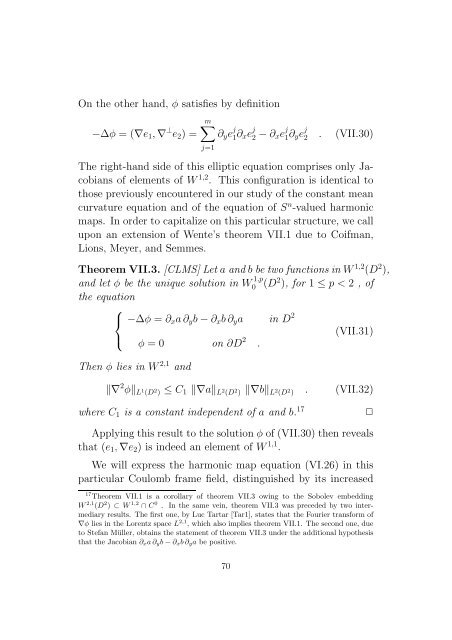Conformally Invariant Variational Problems. - SAM
Conformally Invariant Variational Problems. - SAM
Conformally Invariant Variational Problems. - SAM
You also want an ePaper? Increase the reach of your titles
YUMPU automatically turns print PDFs into web optimized ePapers that Google loves.
On the other hand, φ satisfies by definition<br />
−∆φ = (∇e 1 ,∇ ⊥ e 2 ) =<br />
m∑<br />
∂ y e j 1 ∂ xe j 2 −∂ xe j 1 ∂ ye j 2 . (VII.30)<br />
j=1<br />
The right-hand side of this elliptic equation comprises only Jacobians<br />
of elements of W 1,2 . This configuration is identical to<br />
those previously encountered in our study of the constant mean<br />
curvature equation and of the equation of S n -valued harmonic<br />
maps. In order to capitalize on this particular structure, we call<br />
upon an extension of Wente’s theorem VII.1 due to Coifman,<br />
Lions, Meyer, and Semmes.<br />
Theorem VII.3. [CLMS]Let a andbbe twofunctionsin W 1,2 (D 2 ),<br />
and let φ be the unique solution in W 1,p<br />
0 (D 2 ), for 1 ≤ p < 2 , of<br />
the equation<br />
⎧<br />
⎨ −∆φ = ∂ x a∂ y b−∂ x b∂ y a in D 2<br />
(VII.31)<br />
⎩<br />
φ = 0 on ∂D 2 .<br />
Then φ lies in W 2,1 and<br />
‖∇ 2 φ‖ L1 (D 2 ) ≤ C 1 ‖∇a‖ L2 (D 2 ) ‖∇b‖ L2 (D 2 ) .<br />
where C 1 is a constant independent of a and b. 17<br />
(VII.32)<br />
✷<br />
Applying this result to the solution φ of (VII.30) then reveals<br />
that (e 1 ,∇e 2 ) is indeed an element of W 1,1 .<br />
We will express the harmonic map equation (VI.26) in this<br />
particular Coulomb frame field, distinguished by its increased<br />
17 Theorem VII.1 is a corollary of theorem VII.3 owing to the Sobolev embedding<br />
W 2,1 (D 2 ) ⊂ W 1,2 ∩ C 0 . In the same vein, theorem VII.3 was preceded by two intermediary<br />
results. The first one, by Luc Tartar [Tar1], states that the Fourier transform of<br />
∇φ lies in the Lorentz space L 2,1 , which also implies theorem VII.1. The second one, due<br />
to Stefan Müller, obtains the statement of theorem VII.3 under the additional hypothesis<br />
that the Jacobian ∂ x a∂ y b−∂ x b∂ y a be positive.<br />
70
















